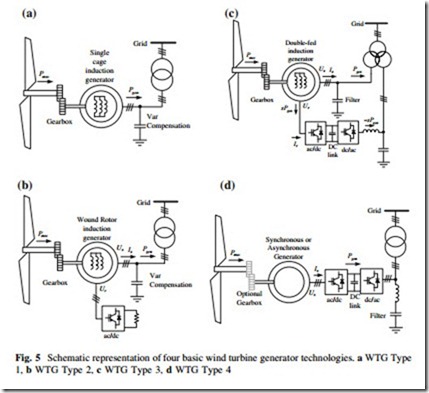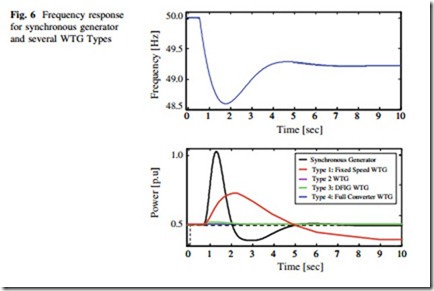Frequency Response of Wind Power
The SFR of future power system is different to the traditional power systems. The massive penetration level of wind power on the power system represents a change from the large-scale interconnected power system design and operation. Wind power generation causes some synchronous generator to be de-committed, and some to be dispatched down to lower power level, it reduces the system inertia. The electromechanical behavior of wind power generators differs fundamentally from that of conventional synchronous generators. Frequency stability and control is a particularly significant issue in future power systems.
Despite the seemingly large variety of utility scale wind turbine technologies in under development, there is an agreement about four basic technologies [17]:
(i) Type 1: Fixed Speed Wind Turbines (FSWT) using Singe Cage Induction Generators (SCIG) (see Fig. 5a).
(ii) Type 2: Variable Speed Wind Turbine (VSWT) using Wound Rotor Induction Generator (WRIG) (see Fig. 5b).
(iii) Type 3: VSWT using Doubly Fed Induction Generator (DFIG) (see Fig. 5c).
(iv) Type 4: VSWT with Full Rated Converter (FRC) interface (see Fig. 5d).
Wind Generation Modelling Group (WGMG) of the Western Electricity Coordinating Council (WECC) and Working Group on Dynamic Performance of Wind Power Generation of IEEE Power System Dynamic Performance Committee have developed and provided specification of generic model for these technologies [17].
Future development in the wind turbine industry will most probably to be focused on a gradual improvement of already known technology. It seems that both Type 3 and Type 4 may still dominate and be very promising wind turbine technologies for large wind farms. Wind turbine Type 4 is a VSWT generator where the output of the generator is passed through the power converter to the grid. There are two types of generators used in these technologies: Electrically Excited Synchronous Generators (EESG) and Permanent Magnet Synchronous Generator (PMSG), and they look very promising wind technologies.
These wind power generation technologies employ power electronic converters, which electrically decoupled the electric generator and its electromechanical behavior from the power system frequency, and they cannot automatically con- tribute to system frequency.
The FR of a WTG depends on mainly on the type of technology. Figure 6 shows the response on active power production for several WTG technologies for a typical system frequency disturbance.
WTG based on Type 1 and Type 2 technologies are directly connected to the grid. FR of these technologies has different characteristic compare with the synchronous generator. They are capable to naturally release kinetic energy stored on their rotating parts (blades, gearbox, generator, etc.) during a system frequency disturbance, they have inertial response [18, 19].
Considering the frequency disturbance shown on Fig. 6, sudden frequency drop, the rotor of Type 1 WTG does not change instantaneously because of the inertia of the wind turbine. However, the power production of this type of tech- nology allows an increase of active power production as consequence of changes on the rotational speed. The active power contribution of Type 1 WTG is higher compared with other WTG technologies, however, it still below FR provided by a classical synchronous generator. Type 2 WTG uses a generator, which is an induction generator with provisions for adjusting its rotor resistance, during system frequency disturbance the active power output is kept at its previous disturbance set value by an adequate adjust of the rotor resistance controller. The FR of this type of WTG is negligible.
Type 3 and Type 4 WTGs are VSWT which use a generators electronically controller and/or electronically connected to the grid. Type 3 and Type 4 WTG do not naturally provide FR. Traditional solutions for this issue are: reduce wind penetration during low system load, modify reserve policy, more static reserve at times of high wind and low system inertia. However, future power systems require maximize power production from wind power, as consequence more effective solutions has been developed: modify existing technology and include of supplementary control loop in the WTGs.
FR, inertia and governor response, can be emulated on generators electronically controller and/or electronically connected to the power system adding a supplementary control, this approach is discussed in next section.

